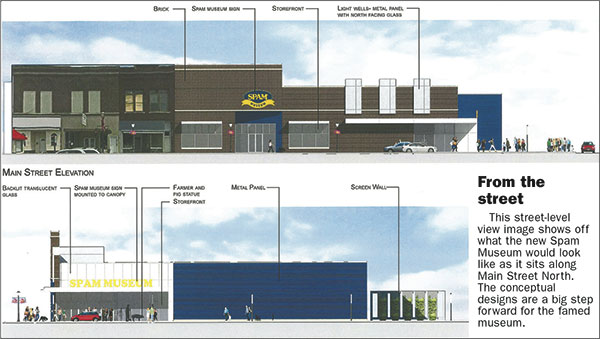What to do with the empty boxes at the edge of town?
The small town of Austin, Minnesota, was faced with this question. They had an answer. The largest employer in town, Hormel Foods, swept-in and transformed an empty K-Mart into something special.
The Spam Museum is one-of-a-kind; there are no others. And, for this small town –home of the famous meat product – it’s an economic driver. Julia Christensen, author of the book Big Box Reuse, describes the feeling of driving into Austin.
As you pull into Austin, MN, you begin to see billboards along the highway advertising the Spam Museum. The billboards say things like “The Spam Museum– Even we don’t really understand,” and “The Spam Museum– Yes, we do answer the ingredients question.” This sense of humor carries over into the actual museum, the shrine to the canned meat that is produced and packaged right there in Austin, Minnesota, otherwise known as Spam Town, USA.
In the early 2000s, the Spam Museum was celebrated as a best-practices example of a repurposing a big box store. Christensen continues;
The renovation on this building has barely left a trace of the original use. In fact, the actual shell of the structure is all that is left of the old K-Mart. Windows, doors, walls, ceilings, and the entire exterior have all been completely overhauled. … This location sat empty for many years, and as a result, the entire end of town began to decline in business, and eventually in value. A grocery store across the street also closed down, leaving another empty big box across the street.

The situation in Austin is similar to so many across the country: The abandoned K-Mart building was on the far edge of Main Street, but in the booming 1990s, K-Mart abandoned this location to construct a new store 1.8 miles away, off the interstate. This is a problem that is most visibly evident in small towns.
The new store has since been shuttered. The Spam Museum and some Hormel office space moved into the old Kmart space after extensive remodeling. It was a success, or was it?
Years passed and local officials started to notice a problem: the location at the edge of town didn’t lend itself to spillover business. People were visiting the museum, and then just leaving town. To quote Austin Mayor Tom Stiehm;
“Today’s visitors can exit Interstate 90, park next to the pork paradise, then pop back on the highway — passing little more than a Kwik Trip along the way.”
Six years after being heralded as a pre-eminent example of big box reuse, it was announced that the Spam Museum was moving downtown.

Herein lies the problem with many big box reuses: the mentality is to dominate markets; to be an island in and of itself. Big box stores do best when they limit customer spillover. This rule imposed, by land use, applies as much to retail as it does to a museum.
We need to start thinking about how we can design places so that they are reusable after their first life-cycle.
When a store is left empty, there are often restrictions imposed upon it. Now, as a direct result of land use covenants that prevent competitors from moving in, many re-use efforts are non-profits, churches, and government agencies, such as the United States’ largest library in McAllen, Texas.
These types of institutions play an important role in society, which should not be understated. But, we should be conscious that big-box land uses are a zero sum game even when they are paying property taxes. For example, a Wal-Mart store pays very little in comparison to the infrastructure used, but a new church pays literally nothing for the large amount of infrastructure used. This problem is something that no reuse can address, aside from possibly the suburban retrofit model (see: Brainerd’s infamous Taco Johns).
Don’t interpret this as a slam against churches, government agencies, or non-profits. I support all three. Yet, when placed within a big box island, the spillover effects are minimized unlike when placed at strategic locations within downtowns or neighborhoods.
I mentioned the country’s largest library in McAllen, Texas. Architecturally speaking, it’s an impressive example of re-using an empty space. The building looks remarkable, but the situation is actually kind of tragic. The public library is in the old Wal-Mart. It was abandoned because Wal-Mart wanted to build a bigger store less than a mile away.

McAllen was clever and did well with the question they were dealt: how do we turn a liability into an asset? You can’t fault McAllen officials for making this move, nor those in Austin. Real progress will be made when we answer by changing the deck to one that doesn’t allow such uses to prosper. Not every town needs (or can support) a library as large as the one in McAllen. What do we do when we have more empty stores than we have civic or religious groups?
We need to start thinking about how we can design places so that they are reusable after their first life-cycle.
